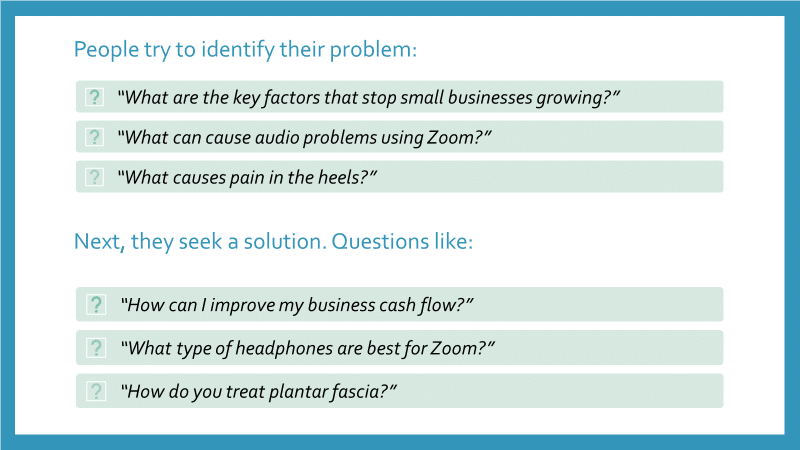Are you planning to write articles to boost the online visibility of your business?
When the pandemic shutdowns began, our ‘online’ world took on new significance. It’s left many business owners with a heightened regard for the value of a strong online presence.
For some types of business, publishing articles is an excellent way to attract readers in the target market, start conversations and generate leads. But before you start writing (or paying blog writers) it’s important to pin down your strategy and plan appropriate topics.
The best place to start is to understand how publishing articles works (when it does) and the common mistakes that could prevent you from getting results. Let’s take a look at the basics.
Choosing the right article topics
A common mistake we see, particularly with small business owners who are just beginning to publish articles, is that they want to write articles that are about their businesses, or that directly attempt to sell products or services. It’s a rookie mistake. That type of content typically has little appeal to readers. To be blunt about it, ‘How Great is My Business’ shouldn’t be the recurring theme of your articles.
So how do you choose the right topics? Thinking about how and why people find and read business blog content can be helpful in this regard.
And one of the most common ways people discover content is by searching for information online.
To generate suitable content ideas for discovery by search, it pays to understand how our search habits, the ‘buyer journey’ and the sales funnel come together.

Searching online for a specific product or service isn’t always the first step in a buyer’s journey towards making a purchase. That first step might have been weeks earlier, when they searched for the answer to a problem.
People might initially search to identify their problem, with questions like:
What are the key factors that stop small businesses growing?
What can cause audio problem on Zoom?
What causes pain in the heels?
These people know they have a problem but might not know exactly what it is.
Once they do, they’ll turn to finding a solution. The information they search for will change:
How can I improve my business cash flow?
What type of headphones are best for Zoom?
How do you treat plantar fascia?

When people search for information like this, Google serves up the content it believes provides quality answers. Often, that content will be on a business blog.
If you Google the question about Plantar Fascia, you’ll see a variety of results – many of them articles on business blogs. When I searched the question, content displayed included content published by a business that sells orthotics, a podiatrist, and Medibank. All of those businesses know that people who have heel pain, are potential customers.
So choosing topics around relevant problems can draw potential customers to your website – and at varying stages of their research and decision making process.
Publishing this type of content typically involves SEO related research to identify popular search terms and questions. You should keep in mind the growing popularity of voice search too, and you can read more about that in our article How to Optimise Content for Voice Search.
But it’s important to realise that this isn’t the only way to use publishing to connect with potential clients. Reaching a targeted audience by sharing your articles on social channels can be just as effective, and in some cases much more effective.
Why ‘optimising’ articles for search isn’t always important
It’s not always important or necessary to optimise articles for search. I’ll explain why by way of examples.
Let’s say you work in the finance sector, and the people you most want to reach are banking executives. You write a detailed analysis of a complex issue that you know is very likely to be of interest to banking executives. But are they searching Google for that topic? Probably not. However, you are connected with banking executives on LinkedIn, so sharing your article on LinkedIn can put your article in front of that audience. Similarly, if your business relies on tender submissions and word of mouth referrals rather than online search, there might be little point or opportunity to optimise relevant topics – but sharing articles with your target audiences on LinkedIn might help you to build credibility and start conversations.
But let’s look at a different situation. You’re a business coach and you want to connect with small business owners in need of help scaling up their businesses. Might these people be searching for information via Google? Yes. Lots of information, on a very broad range of topics. As a result, you might decide to arrange some SEO research so you have data on relevant search terms and questions and can create content around those to attract more people to your website.
But again, it’s not the only way to connect with those people. You can reach them by sharing content on social media and into targeted social media groups.
Another example. You’re a suburban podiatrist. You do some SEO research and see that every month, 200 people search for information about an issue you specialise in treating. So if you create a quality article, 200 people a month could read it, right? Well, they could, but that’s unlikely. For that to happen your article would have to rank higher than existing articles on the same topic. However, the bigger problem for you is that those 200 searches are for the whole of Australia – so depending on where you are, perhaps only a few of those 200 are potential customers at all.
All is not lost though – if you’re publishing great content and sharing it on your social channels, potential benefits include:
- Connecting with those people in your area who do search for information
- Expanding your social media audiences so that more people see your content
- Potential benefit for your website SEO overall
- Boosting your personal reputation as an expert in your field
So when it comes to choosing topics, knowing your purpose in publishing is essential. Even more essential, is that no matter why you’re creating the content, it should be of the highest possible quality if you want people to read it.
Content quality
Once you’ve chosen some ideal topics, writing a few basic articles probably won’t do you much good at all. Google wants to present the best quality content to people, so low-quality articles have less chance of ranking in the results.
But there’s an even better reason to keep the quality high. When readers arrive on your blog and start reading your content, you want them to think “Wow, this is really helpful” or “This is very useful – it’s just the information I was hoping to find”.
If your content is disappointing and unhelpful, people will click the back button and continue looking. And publishing won’t have done you any good at all.
Similarly, if you’re targeting a niche audience on LinkedIn, your content needs to interest and impress that audience if you hope to see results.
Sharing your articles on social media
Once you’ve published your fabulous high-quality articles, if you wait for people to find that them by search alone, that’s going to be limiting. You need to share the content on social media channels to get more readers.
If you have very few followers on social channels, give some thought to building up these audiences. The bigger your audience, the more people see content that you publish (without you having to pay for it). There are several tactics you can use to build your audience, from being sure to include links to your social channels on your website, and using the available tools to ask existing friends and connections to like or follow your business pages, through to using post boosts and other paid ads.
You can read more about building social media audiences here.
Capturing leads
So now…you’ve got fabulous content, you’ve been sharing it, and people are visiting to read the content. But what if they’re not ready to buy yet? And in a couple of weeks or months when they are ready, they can’t remember your business name or your website address? This is where lead capture comes.
I’m sure you’ve seen lead capture at work – it’s where you have to supply your email address to get something you want. It might be an ebook or white paper, or a newsletter subscription. Or a quick quote. Or a free template, course or webinar.

When you’re capturing leads, you’re building a database of people who are interested, but perhaps not quite ready to buy.
You can then engage with those people. You might do that via a newsletter, letting them know about new content you’ve published, or special offers. When they are ready to buy, there’s now a better chance that your business will come to mind.
Lead capture may not be appropriate for every type of business, but it certainly works for many, and the advantages are huge.
(Read more about why and how to use lead capture in our post What is Lead Capture.)
Persistence
And last but never least – be persistent in your efforts. Publishing 1-2 articles then giving up certainly isn’t going to bring a stampede of leads to your door. View your publishing in terms of building up your content assets – because part of the value in publishing articles, is that once they’re published, they can keep on working.
Content can and should be reviewed from time to time. Refresh outdated articles. If you’ve got articles that are lacking in detail and not attracting readers, consider revising them, either to add more detail, or refine the topic so it’s more useful to readers. Aim for continual improvement in terms of choosing great topics and producing quality content.
If your company blog aleady has plenty of content, and your challenge is in managing the blog and keeping the content up-to-date, speak to us about our blog writing and blog management services!




